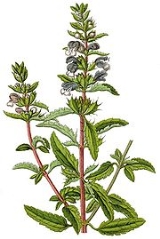
Dracocephalum
Encyclopedia
Dracocephalum is a genus
of about 45 species of flowering plant
s in the family Lamiaceae
, native to temperate regions of the Northern Hemisphere
. They are annual
or perennial
herbaceous
plants or subshrub
s, growing to 15-90 cm tall.
Selected species
Dracocephalum moldavicum is also known as Moldavian Balm, Moldavian Dragon's Head, or simply the Dragonhead. It is an erect, bushy, branching plant found from eastern Europe
to Siberia
.
Genus
In biology, a genus is a low-level taxonomic rank used in the biological classification of living and fossil organisms, which is an example of definition by genus and differentia...
of about 45 species of flowering plant
Flowering plant
The flowering plants , also known as Angiospermae or Magnoliophyta, are the most diverse group of land plants. Angiosperms are seed-producing plants like the gymnosperms and can be distinguished from the gymnosperms by a series of synapomorphies...
s in the family Lamiaceae
Lamiaceae
The mints, taxonomically known as Lamiaceae or Labiatae, are a family of flowering plants. They have traditionally been considered closely related to Verbenaceae, but in the 1990s, phylogenetic studies suggested that many genera classified in Verbenaceae belong instead in Lamiaceae...
, native to temperate regions of the Northern Hemisphere
Northern Hemisphere
The Northern Hemisphere is the half of a planet that is north of its equator—the word hemisphere literally means “half sphere”. It is also that half of the celestial sphere north of the celestial equator...
. They are annual
Annual plant
An annual plant is a plant that usually germinates, flowers, and dies in a year or season. True annuals will only live longer than a year if they are prevented from setting seed...
or perennial
Perennial plant
A perennial plant or simply perennial is a plant that lives for more than two years. The term is often used to differentiate a plant from shorter lived annuals and biennials. The term is sometimes misused by commercial gardeners or horticulturalists to describe only herbaceous perennials...
herbaceous
Herbaceous
A herbaceous plant is a plant that has leaves and stems that die down at the end of the growing season to the soil level. They have no persistent woody stem above ground...
plants or subshrub
Subshrub
A subshrub or dwarf shrub is a short woody plant. Prostrate shrub is a similar term.It is distinguished from a shrub by its ground-hugging stems and lower height, with overwintering perennial woody growth typically less than 10–20 cm tall, or by being only weakly woody and/or persisting...
s, growing to 15-90 cm tall.
Selected species
- Dracocephalum argunense
- Dracocephalum austriacum
- Dracocephalum botryoides
- Dracocephalum bullatum
- Dracocephalum calophyllum
- Dracocephalum forrestii
- Dracocephalum grandiflorum
- Dracocephalum hemsleyanum
- Dracocephalum heterophyllum
- Dracocephalum imberbe
- Dracocephalum isabellae
- Dracocephalum moldavicumDracocephalum moldavicumDracocephalum moldavicum is a herbaceous plant species in the genus Dracocephalum...
- Dracocephalum nutans : Nodding Dragonhead
- Dracocephalum parviflorumDragonhead mintDragonhead mint or American dragonhead is a wild North American mint growing from New York state through the Midwest and Canada and into Alaska. It grows as either an annual or biennial, producing clusters of small pink to violet flowers in whorls at the ends of many branching stems...
, Dragonhead mint or American dragonhead - Dracocephalum peregrinum
- Dracocephalum purdomii
- Dracocephalum renatii
- Dracocephalum rupestreDracocephalum rupestreDracocephalum rupestre is a herbaceous plant species in the genus Dracocephalum...
- Dracocephalum ruyschiana
- Dracocephalum tanguticum
- Dracocephalum thymifolium
- Dracocephalum wallichii
Dracocephalum moldavicum is also known as Moldavian Balm, Moldavian Dragon's Head, or simply the Dragonhead. It is an erect, bushy, branching plant found from eastern Europe
Europe
Europe is, by convention, one of the world's seven continents. Comprising the westernmost peninsula of Eurasia, Europe is generally 'divided' from Asia to its east by the watershed divides of the Ural and Caucasus Mountains, the Ural River, the Caspian and Black Seas, and the waterways connecting...
to Siberia
Siberia
Siberia is an extensive region constituting almost all of Northern Asia. Comprising the central and eastern portion of the Russian Federation, it was part of the Soviet Union from its beginning, as its predecessor states, the Tsardom of Russia and the Russian Empire, conquered it during the 16th...
.

